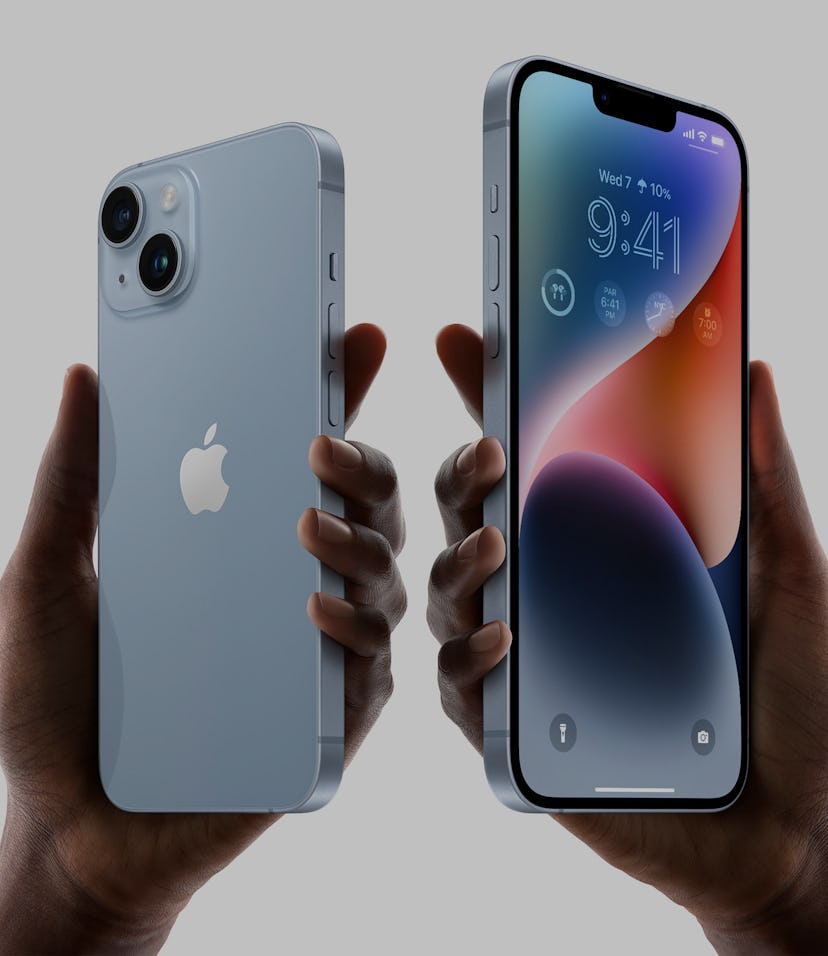The New Flagship
Apple’s iPhone 14 Pro trades the notch for animated 'dynamic island'
Apple is adding new sizes to the entry-level iPhone 14 while keeping most of the new features — including a pill-shaped notch — for the iPhone 14 Pro.

Apple’s new iPhone 14 family is finally making a clear distinction between the company’s entry-level and “Pro” devices. This year, Apple is releasing the iPhone 14 with a 6.1-inch display and an iPhone 14 Plus model with a 6.7-inch screen; RIP iPhone mini.
The bigger iPhone 14 Plus should sell better than the iPhone 13 mini, but the 6.1-inch iPhone 14 Pro and 6.7-inch iPhone 14 Pro Max are the ones that are truly new, with cameras, display, internals, and the notch all getting major upgrades.
iPhone 14 and 14 Plus
As predicted, changes to the iPhone 14 are minor, but not insignificant. The iPhone 14 looks pretty much like the iPhone 13 before it. Flat edges with a mix of aluminum and glass, this time in midnight, starlight, blue, purple, and red color options. Even the notch is exactly the same as on iPhone 13.
Déjà vu — In an unusual turn, Apple is also keeping things more or less the same on the inside of the iPhone 14. The company says the iPhone 14 internals have been updated for better cooling, but the actual chip they're housing should be familiar.
Apple has plucked the A15 Bionic chip from the iPhone 13 Pros and plopped them into the iPhone 14 and iPhone 14 Plus. So while the CPU performance in iPhone 14s are identical to the iPhone 13s, the GPU at least has the five cores present in the iPhone 13 Pros instead of the four cores in the iPhone 13s.
Considering how much of a leg up on Qualcomm Snapdragon chips that Apple has with its custom SoCs, it shouldn’t be too surprising the company thinks using last year’s chip in its non-Pro iPhone 14s is totally fine.
Camera improvements — Every year Apple finds an excuse to tweak the iPhone’s camera system and this year is no different. The iPhone 14 has a 12-megapixel wide (with sensor-shift OIS and 49 percent better low-light capture) and a 12-megapixel ultrawide (ƒ/2.4 aperture and a 120° field of view). The new 12-megapixel TrueDepth selfie camera also has autofocus for the first time.
The same photographic styles and cinematic mode that Apple introduced last year are on board, but now Apple is also improving things by changing how it applies its Deep Fusion photo processing. It’s calling the new low-light capabilities “Photonic Engine” and promising two times better low-light performance or more across all of the iPhone 14s cameras.
The new “Action Mode” video stabilization feature replaces the need for a gimbal (at least in theory) by offering even better video stabilization. It’s hard to tell how much of a difference it will make based on Apple’s short demo, but given Apple’s best-in-class video performance, it certainly seems promising.
iPhone 14 Pro and Pro Max
Things really get interesting on the iPhone 14 Pro and 14 Pro Max. The notch is gone and replaced with a pill-shaped cutout that manages to still house the Face ID sensors and selfie camera. The 120Hz high refresh rate display is gaining always-on capabilities, all the better for iOS 16 lock screen widgets. In a change from last year, Apple is also dropping the sierra blue color option for space black, silver, gold, and new deep purple.
The changes to the notch are... kind of staggering. Yes, it’s pill-shape as predicated, but now Apple considers that space to be an interface element it calls the “Dynamic Island.” Apps can minimize and cover the notch area, offering little nibbles of information that can be expanded into widget-like features as you might find on the new iOS 16 lock screen.
A16 Bionic chip — Apple’s newest silicon improvements are modest in comparison to previous years, but obviously, make the iPhone 14 Pro models stand out from their non-Pro siblings. The new A16 Bionic is built on a 4-nanometer process, with a Neural Engine that can do 17 trillion operations per second and a GPU with 50 percent more memory bandwidth.
48-megapixel camera — Apple is finally bumping up the megapixel count and sensor size of the iPhone 14 Pros’ wide camera to 48-megapixels with a 65 percent larger sensor, along with offering 12 megapixels on the telephoto and 12 megapixels on the ultrawide. The front selfie camera is also improved with a 12-megapixel sensor and — for the first time ever — autofocus, just like the base iPhone 14.
Satellites! — As part of a larger push Apple’s making across its products, the iPhone 14 family (Pro and regular) is getting a new Emergency SOS feature enabled by satellite connectivity. Apple tweaked the iPhone 14’s antennas and added new software to direct you on how to maintain a connection to the satellite network. Using the connection, you can send the necessary information to emergency responders (your location, if anyone is injured, short texts, etc...) or simply share your location in the Find My app in non-emergency situations, without having to be near a cell tower.
The feature will be available in November in the U.S. and Canada, and free for two years on iPhone 14 models. What it costs after that remains to be seen.
Pre-order, release date, and pricing
Apple’s iPhone 14 and 14 Pros will be available to preorder on Friday, September 9, starting at $799 for the regular iPhone 14, $899 for the iPhone 14 Plus, $999 for the iPhone 14 Pro, and $1099 for the iPhone 14 Pro Max.
iPhone 14, 14 Pro, and 14 Pro Max will ship September 16, while iPhone 14 Plus ships October 7.